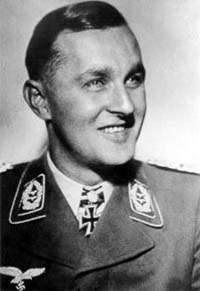Adolf Dickfeld
| Adolf Dickfeld | |
|---|---|
 Adolf Dickfeld | |
| Born |
20 February 1910 Jüterbog in Brandenburg |
| Died |
17 May 2009 (aged 99) Dreieich in Hesse |
| Allegiance |
|
| Service/branch |
|
| Years of service | 1937–45 |
| Rank | Oberst |
| Unit | JG 52, JG 2, JG 11 |
| Commands held | II./JG 11 |
| Battles/wars | |
| Awards | Knight's Cross of the Iron Cross with Oak Leaves |
Oberst Adolf Dickfeld (20 February 1910 – 17 May 2009) was a German World War II Luftwaffe 136 victories Flying ace. A flying ace or fighter ace is a military aviator credited with shooting down five or more enemy aircraft during aerial combat.[1] He was also a recipient of the Knight's Cross of the Iron Cross with Oak Leaves (German: Ritterkreuz des Eisernen Kreuzes mit Eichenlaub). The Knight's Cross of the Iron Cross and its higher grade Oak Leaves was awarded to recognise extreme battlefield bravery or successful military leadership.
Early life and career
Dickfeld was born on 20 February 1910 in Jüterbog in the Province of Brandenburg, the son of an artillery officer. In his youth he learned to fly glider aircraft. He made his first flights at the glider school in Grunau in Silesia, present-day Jeżów Sudecki, Poland. Here, among others, he was taught to fly by Hanna Reitsch. He was also trained by Wolf Hirth on the Hornberg in the Black Forest, and by Heini Dittmar and Oskar Ursinus at the Wasserkuppe in the Rhön Mountains.[2]
World War II
On 18 May 1942, Dickfeld was credited with his 100th aerial victory. He was the 8th Luftwaffe pilot to achieve the century mark.[3]

Dickfeld was officially credited with 136 victories claimed in 1072 combat missions. He also claimed a further 15 enemy aircraft unconfirmed.[4] In 1943 he was placed in a staff position as General für Nachwuchs (general of procreation/recruitment) of the Luftwaffe in the Reich Air Ministry and at the same time became Reich inspector of the Flieger (Aviation) Hitler Youth. He claimed about 128 victories over the Eastern Front. He claimed one victory flying the Heinkel He 162 Salamander ("Volksjäger") jet fighter, a P-47 Thunderbolt on 11 April 1945.
Dickfeld continued to fly professionally in Germany and East Africa. He died on 17 May 2009 in Dreieich.[5][6]
Awards
- Iron Cross (1939)
- Ehrenpokal der Luftwaffe on 15 December 1941 as Leutnant and pilot[8][9]
- German Cross in Gold on 22 January 1942 as Leutnant of the Reserves in the 7./JG 52[10]
- Knight's Cross of the Iron Cross with Oak Leaves
- Royal Bulgarian Merit medal in Gold
- Mentioned in the Wehrmachtbericht
Notes
References
Citations
- ↑ Spick 1996, pp. 3–4.
- ↑ Stockert 1996, p. 435.
- ↑ Obermaier 1989, p. 243.
- ↑ Dickfeld 2005, p. 390.
- ↑ 12oclockhigh forum
- ↑ axishistory forum
- 1 2 Thomas 1997, p. 116.
- ↑ Patzwall 2008, p. 65.
- ↑ Obermaier 1989, p. 50.
- ↑ Patzwall & Scherzer 2001, p. 83.
- ↑ Fellgiebel 2000, p. 160.
- 1 2 Scherzer 2007, p. 271.
- ↑ Fellgiebel 2000, p. 59.
Bibliography
- Dickfeld, Adolf (2005). Die Fährte des Jägers — Kriegerlebnisse eines Jagdfliegers [The Path of the Hunter — War Experiences of a Fighter Pilot] (in German). Schnellbach, Germany: Verlag Siegfried Bublies. ISBN 978-3-926584-37-3.
- Fellgiebel, Walther-Peer (2000) [1986]. Die Träger des Ritterkreuzes des Eisernen Kreuzes 1939–1945 — Die Inhaber der höchsten Auszeichnung des Zweiten Weltkrieges aller Wehrmachtteile [The Bearers of the Knight's Cross of the Iron Cross 1939–1945 — The Owners of the Highest Award of the Second World War of all Wehrmacht Branches] (in German). Friedberg, Germany: Podzun-Pallas. ISBN 978-3-7909-0284-6.
- MacLean, French L (2007). Luftwaffe Efficiency & Promotion Reports: For the Knight's Cross Winners. Atglen, Pennsylvania: Schiffer Military History. ISBN 978-0-7643-2657-8.
- Obermaier, Ernst (1989). Die Ritterkreuzträger der Luftwaffe Jagdflieger 1939 – 1945 [The Knight's Cross Bearers of the Luftwaffe Fighter Force 1939 – 1945] (in German). Mainz, Germany: Verlag Dieter Hoffmann. ISBN 978-3-87341-065-7.
- Patzwall, Klaus D.; Scherzer, Veit (2001). Das Deutsche Kreuz 1941 – 1945 Geschichte und Inhaber Band II [The German Cross 1941 – 1945 History and Recipients Volume 2] (in German). Norderstedt, Germany: Verlag Klaus D. Patzwall. ISBN 978-3-931533-45-8.
- Patzwall, Klaus D. (2008). Der Ehrenpokal für besondere Leistung im Luftkrieg [The Honor Goblet for Outstanding Achievement in the Air War] (in German). Norderstedt, Germany: Verlag Klaus D. Patzwall. ISBN 978-3-931533-08-3.
- Scherzer, Veit (2007). Die Ritterkreuzträger 1939–1945 Die Inhaber des Ritterkreuzes des Eisernen Kreuzes 1939 von Heer, Luftwaffe, Kriegsmarine, Waffen-SS, Volkssturm sowie mit Deutschland verbündeter Streitkräfte nach den Unterlagen des Bundesarchives [The Knight's Cross Bearers 1939–1945 The Holders of the Knight's Cross of the Iron Cross 1939 by Army, Air Force, Navy, Waffen-SS, Volkssturm and Allied Forces with Germany According to the Documents of the Federal Archives] (in German). Jena, Germany: Scherzers Militaer-Verlag. ISBN 978-3-938845-17-2.
- Spick, Mike (1996). Luftwaffe Fighter Aces. New York: Ivy Books. ISBN 978-0-8041-1696-1.
- Stockert, Peter (1996). Die Eichenlaubträger 1939–1945 Band 1 [The Oak Leaves Bearers 1939–1945 Volume 1] (in German). Bad Friedrichshall, Germany: Friedrichshaller Rundblick. ISBN 978-3-9802222-7-3.
- Thomas, Franz (1997). Die Eichenlaubträger 1939–1945 Band 1: A–K [The Oak Leaves Bearers 1939–1945 Volume 1: A–K] (in German). Osnabrück, Germany: Biblio-Verlag. ISBN 978-3-7648-2299-6.
- Die Wehrmachtberichte 1939–1945 Band 2, 1. Januar 1942 bis 31. Dezember 1943 [The Wehrmacht Reports 1939–1945 Volume 2, 1 January 1942 to 31 December 1943] (in German). München, Germany: Deutscher Taschenbuch Verlag GmbH & Co. KG. 1985. ISBN 978-3-423-05944-2.
